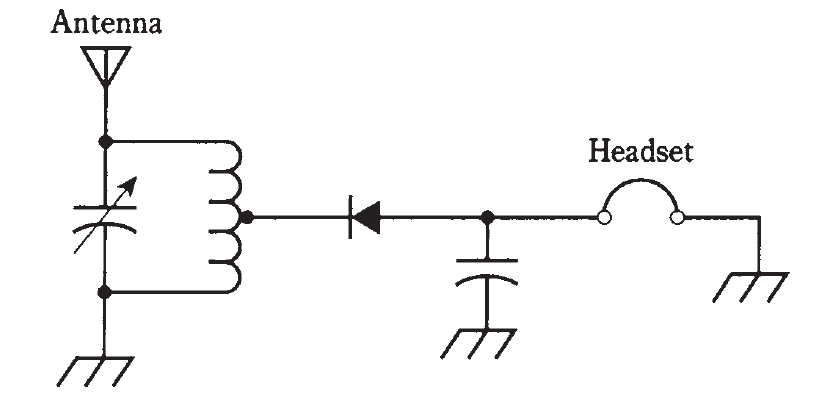
Detection
 المؤلف:
Stan Gibilisco
المؤلف:
Stan Gibilisco
 المصدر:
Teach Yourself Electricity and Electronics
المصدر:
Teach Yourself Electricity and Electronics
 الجزء والصفحة:
372
الجزء والصفحة:
372
 5-5-2021
5-5-2021
 1566
1566
Detection
One of the earliest diodes, existing even before vacuum tubes, was a semiconductor. Known as a cat whisker, this semiconductor consisted of a fine piece of wire in contact with a small piece of the mineral galena. This bizarre-looking thing had the ability to act as a rectifier for small radio-frequency (RF) currents. When the cat whisker was connected in a circuit like that of Fig. 1, the result was a receiver capable of picking up amplitude-modulated (AM) radio signals.

Fig. 1: Schematic diagram of a crystal set radio receiver.
A cat whisker was a finicky thing. Engineers had to adjust the position of the fine wire to find the best point of contact with the galena. A tweezers and magnifying glass were invaluable in this process. A steady hand was essential.
The galena, sometimes called a “crystal,” gave rise to the nickname crystal set for this low-sensitivity radio. You can still build a crystal set today, using a simple RF diode, a coil, a tuning capacitor, a headset, and a long-wire antenna. Notice that there’s no battery! The audio is provided by the received signal alone.
The diode in Fig. 1 acts to recover the audio from the radio signal. This is called detection; the circuit is a detector. If the detector is to be effective, the diode must be of the right type. It should have low capacitance, so that it works as a rectifier at radio frequencies, passing current in one direction but not in the other. Some modern RF diodes are actually microscopic versions of the old cat whisker, enclosed in a glass case with axial leads. You have probably seen these in electronics hobby stores. Some detectors use diodes; others do not.
 الاكثر قراءة في الألكترونيات
الاكثر قراءة في الألكترونيات
 اخر الاخبار
اخر الاخبار
اخبار العتبة العباسية المقدسة


